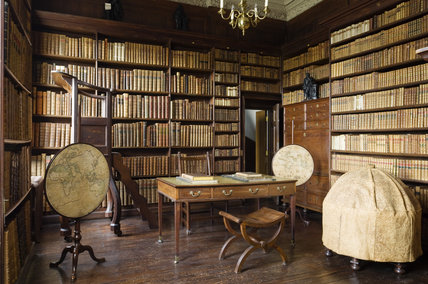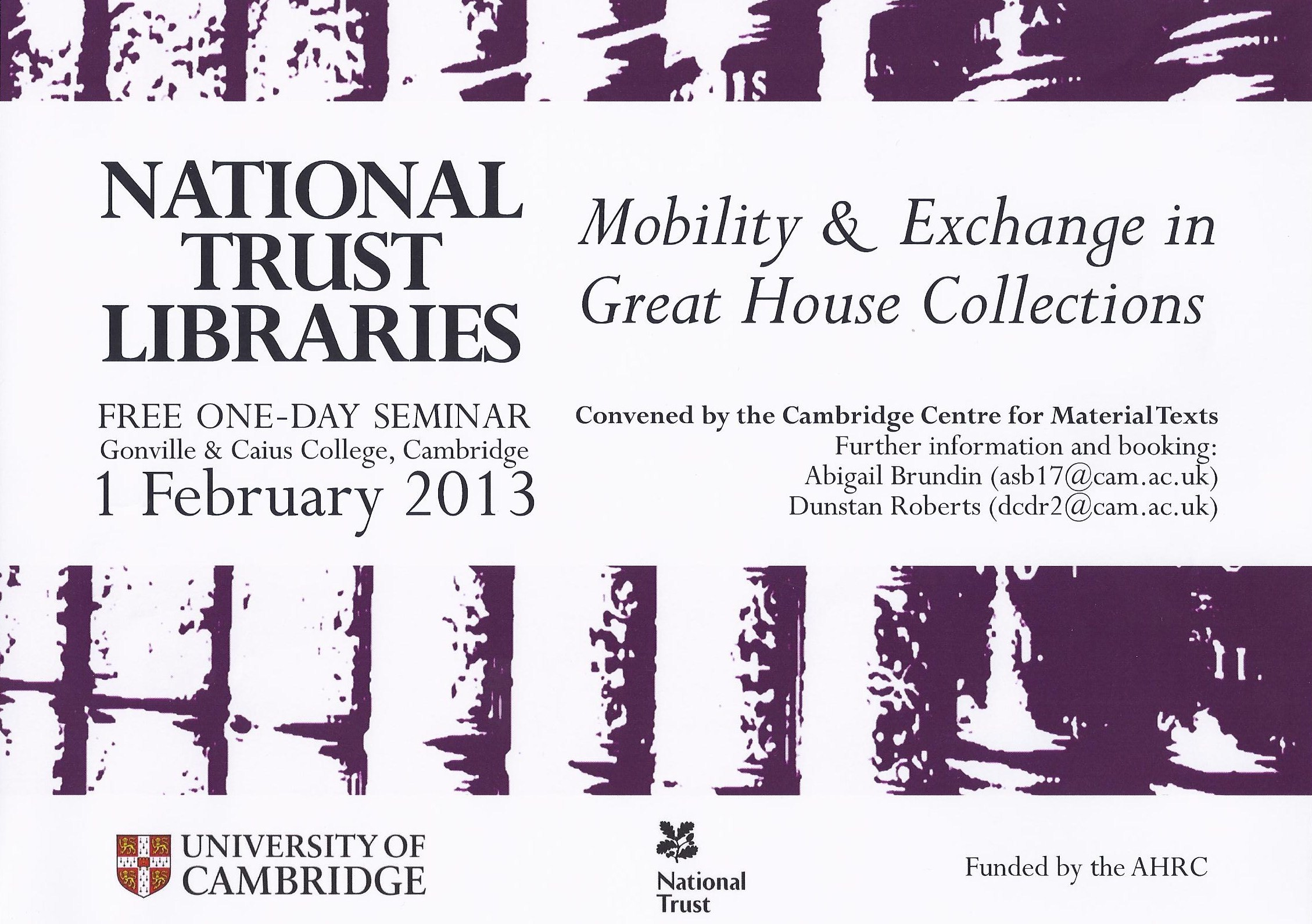Last Friday the CMT hosted a one-day, AHRC-funded seminar on National Trust Libraries, organized by Dr Abigail Brundin of the Cambridge Italian Department. 45 librarians, curators, academics and postgraduate researchers from up and down the country came together to discuss ‘Mobility and Exchange in Great House Collections’, and to celebrate the unveiling of a new resource for cultural history.
 Everyone who has been to a NT property will have had the experience of visiting the library and seeing rows and rows of books, intriguing but inaccessible, lining the shelves. Did they really matter? Or were they (as the cliché has it) bought by the yard by unthinking aristos who hoped they would help to keep out the cold? Only now, as the cataloguing of the Trust’s collections reaches its conclusion, can we begin to answer that question.
Everyone who has been to a NT property will have had the experience of visiting the library and seeing rows and rows of books, intriguing but inaccessible, lining the shelves. Did they really matter? Or were they (as the cliché has it) bought by the yard by unthinking aristos who hoped they would help to keep out the cold? Only now, as the cataloguing of the Trust’s collections reaches its conclusion, can we begin to answer that question.
The NT’s libraries are overwhelming in scale–over 140 collections, with 230,000 books in 400,000 volumes, much if not all of which is now catalogued in impressive copy-specific detail on COPAC. Both the cataloguing and the collections are overseen by the indefatigable Libraries Curator, Mark Purcell, who took us on a whistlestop powerpoint tour of his dominions. Like the houses, the libraries as he described them are complexly layered–brought together, broken up, moved around often over hundreds of years–so that understanding them requires a kind of archaeological reconstruction. Each library is a research project, or many research projects, waiting to happen. Purcell flashed up some of the highlights–masterpieces of printing or exceptionally rare titles–whetting the appetite for further exploration.
Elsewhere in the day, six papers illuminated different aspects of Great House library history. Guyda Armstrong (Manchester) kicked off with a discussion of the Chatsworth manuscript of Boccaccio’s De claris mulieribus, drawing out the pointed significance of presenting this discussion of good and bad women to Henry VIII, who had just executed his fifth wife, Catherine Howard, together with the daughter of the work’s translator, Lord Morley. Tracing the roundabout route by which the manuscript had made its way to the Chatsworth collection, Armstrong asked why the manuscript had always been so undervalued, and described some of the difficulties of gaining access to it today. John Gallagher (Cambridge) began his paper on ‘Reading and the Grand Tour’ by drawing a sharp contrast between the stasis of old books held in modern research libraries and the likely mobility of the same books in their early lives. His research shows how travellers bought, transported and discarded books according to the needs of the moment, often guided by their desire to pick up a fashionable smattering of a foreign tongue. Dunstan Roberts (Cambridge) followed this up with an account of the books that various generations of the Brownlow family of Belton House in Lincolnshire had bought on the Grand Tour. Putting the surviving books together with surviving lists of travel expenses provides a startlingly immediate sense of the priorities of eighteenth-century tourists, and of the cultural horizons that their journeys opened up. You can find sculptures by Canova in the Hermitage and Louvre, but there’s also one in the local church at Belton, thanks to the savvy of one heir to the family estates.
In the next session, Hannah Degroff (York) pointed to the difficulties of establishing exactly where books were kept in the historic house, in her case Castle Howard. The evidence is tantalizingly vague, but suggests that there may have been several separate collections within the house, and that these moved around in response to the changing circumstances of their ageing owner, the 3rd Earl of Carlisle. Susie West (Open University) extended that discussion by looking at the changing shape and location of aristocratic study libraries from the late seventeeth-century into the eighteenth century, during which time they moved from a position adjacent to the bedchamber to a more public situation where they worked as a variant of the parlour. Her study also challenged the tendency of literary historians to privilege the closet as a site of privacy and (especially female) agency; the fluidity of nomenclature in this period makes it hard to distinguish closets from studies, and the fluidity of room usage may muddy the waters still further. Finally Ed Potten (Cambridge University Library) asked why nineteenth-century libraries had received so little scrutiny. Focusing on the libraries at Nostell Priory and Tatton Park, he suggested that the idea of the ‘bibliophile’ or the ‘collector’ (or worse still, the ‘bibliomaniac’) obscured the intellectual vitality of bookbuying and reading in the period.
The seminar concluded with a round-table discussion chaired by David Pearson (London), along with Warren Boutcher (Queen Mary), Stephen Parkin (British Library), Nicholas Pickwoad (NT) and Jason Scott-Warren (Cambridge), which considered some of the key issues facing the NT libraries as their cataloguing programme draws to a conclusion. How will the Trust cope with the expanding pressure for access? How can we  balance increased access with the need to conserve the collections? How do we raise public awareness of the significance of these libraries? The last question generated the liveliest discussion: put simply, it will take money and labour to bring these libraries back to life, and nobody knows (yet) where that money and labour will come from.
balance increased access with the need to conserve the collections? How do we raise public awareness of the significance of these libraries? The last question generated the liveliest discussion: put simply, it will take money and labour to bring these libraries back to life, and nobody knows (yet) where that money and labour will come from.
You can keep up to date with the NT libraries by signing up to their Facebook page here. And the CMT is helping to organize an exhibition at Belton House between 2 March and 3 November 2013 which will showcase some of the fruits of its pilot project on Italian books in the library there–please come and see it!